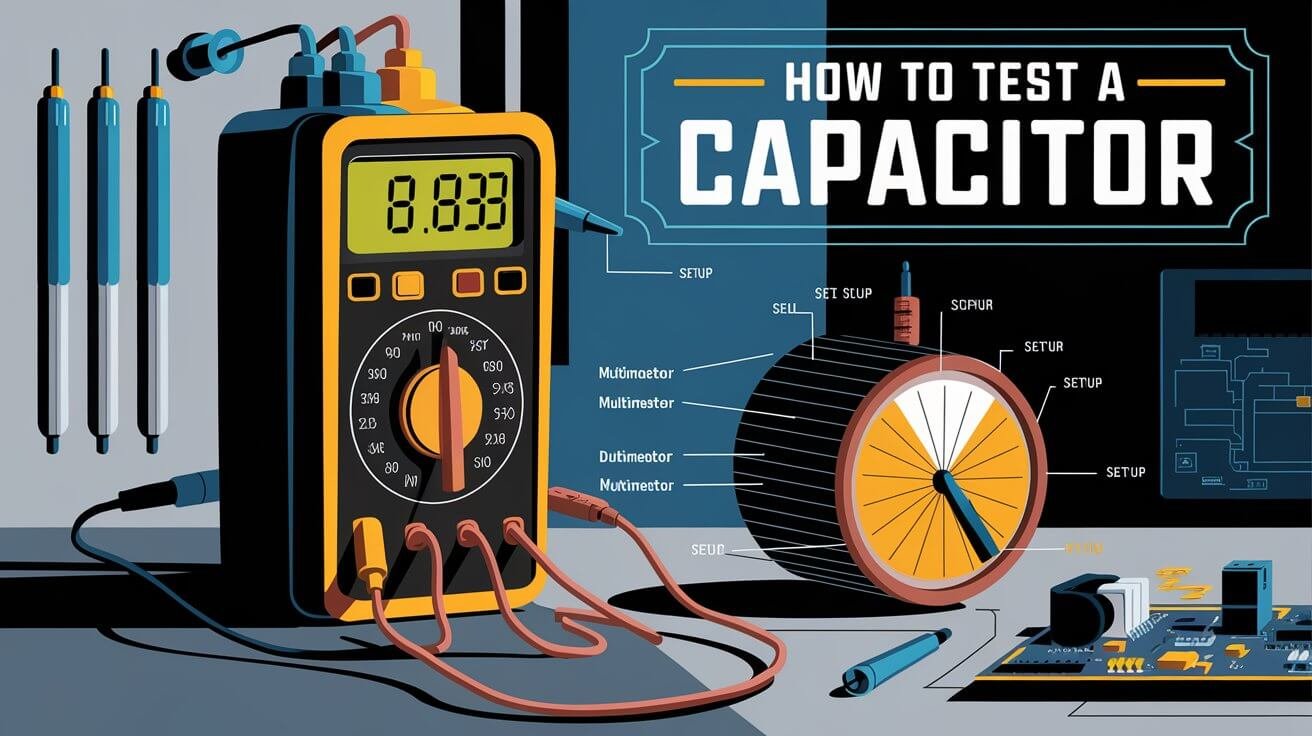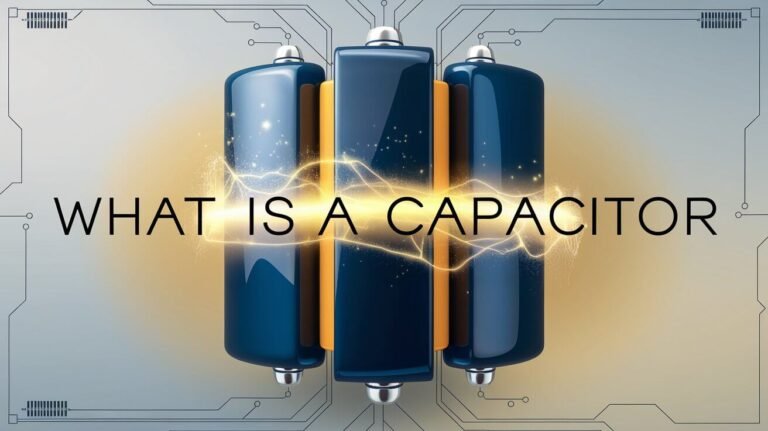
Capacitors are key in electronics, storing voltage for circuits. They’re in many devices, like power supplies and appliances. There are two types: electrolytic and non-electrolytic, which control current flow.
Testing capacitors regularly is important. Bad capacitors can mess up circuits, leading to high bills and equipment failures. Knowing how to test capacitors helps keep devices working well.
Testing capacitors is critical for their performance. A multimeter can check their capacitance value. This is key for a circuit’s operation. We’ll look at how to test capacitors, including with digital and analog multimeters. This ensures devices work at their best.
Safety Precautions for Capacitor Testing
Working with capacitors requires careful safety steps to avoid electrical shocks or damage. Make sure all power sources are off before starting. Use a multimeter to check for any remaining voltage. Capacitors can hold electrical charges even when power is off, so it’s important to discharge them safely.
Wear protective gear like insulated gloves and safety glasses for safety. A clean, well-lit workspace is also key for safe testing. Here are some important tips for setting up a safe workspace:
Required Safety Equipment
- Insulated gloves to prevent electrical shock
- Safety glasses to protect eyes from debris or electrical arcs
- A multimeter for verifying the absence of voltage
- A resistor for discharging capacitors
Discharge Protocols
Discharging a capacitor means connecting a resistor to its leads to release the charge. This is a critical step before measuring or handling the capacitor. Always stick to established discharge protocols for your safety and the safety of your equipment.
Workspace Setup Requirements
A clean, well-lit, and organized workspace is vital for safe capacitor testing. Keep your area free from clutter and electrical dangers. Make sure all safety gear is within reach. By focusing on capacitor safety and proper discharge, you can reduce risks and ensure a successful test.
| Equipment | Purpose |
|---|---|
| Insulated Gloves | Prevent electrical shock |
| Safety Glasses | Protect eyes from debris or electrical arcs |
| Multimeter | Verify absence of voltage |
| Resistor | Discharge capacitors |
Essential Tools for Capacitor Testing
Testing capacitors requires the right tools. A multimeter is good for measuring capacitance and resistance. But, for better accuracy, a capacitance meter is best. The QuadTech 1920 Precision LCR Meter and the Sencore LC75, LC102, and LC103 are top choices.
An ESR meter is also key for capacitor testing. The AnaTek Instruments Blue ESR Tester by Bob Parker is a favorite among techs. Some tools, like the Handheld BK Precision 878, can also test capacitors.
Choosing the right tool depends on the capacitor type and needed accuracy. For instance, leakage testing is vital. A tool like the Leakseeker 89 helps find shorts on PCBs. With the right tools and methods, technicians get accurate and reliable results.
When picking a tool for capacitor testing, consider these points:
- Accuracy and precision
- Ease of use
- Compatibility with different types of capacitors
- Additional features, such as ESR measurement and leakage testing
Basic Capacitor Functions and Components
Capacitors are key in electronic circuits. Knowing their functions and types is vital for keeping motors, appliances, and gadgets working well. Electrolytic capacitors, for example, are great for storing energy and are cost-effective.
It’s important to understand capacitor ratings to pick the right one for the job. Capacitors can fail for many reasons like leakage or overheating. Look out for signs like bulging or slow starts in motors.
Types of Capacitors
- Ceramic capacitors: suitable for high-frequency applications
- Electrolytic capacitors: often used in energy storage and power filter applications
- Tantalum capacitors: known for their stability and high capacitance in a small package
Common Capacitor Ratings
Capacitor ratings include capacitance, voltage, and tolerance. Knowing these is key to choosing the right capacitor. For instance, high voltage capacitors are needed for high voltage applications.
Signs of Capacitor Failure
Failed capacitors show signs like bulging or leakage. They can also cause motors to start slowly. Regular checks are vital to avoid failure and keep gadgets running smoothly. Allied Components International offers info on capacitors and more.
| Capacitor Type | Characteristics | Applications |
|---|---|---|
| Electrolytic Capacitors | Large capacitance, cost-effective | Power supplies, energy storage |
| Ceramic Capacitors | High-frequency applications, stable | Signal processing, power supplies |
| Tantalum Capacitors | Stable, high capacitance, small package | Precision electronics, medical devices |
How To Test A Capacitor With A Multimeter
To test a capacitor with a multimeter, follow these steps. First, make sure the capacitor is fully discharged to avoid injury. You can do this by connecting a 10k ohm resistor across the terminals. Then, set your multimeter to measure capacitance.
For polarized capacitors, connect the red probe to the positive terminal and the black probe to the negative. Non-polarized capacitors can be connected either way. After connecting, check the multimeter’s display for the capacitance value.
The value should be close to the capacitor’s rated value to be good. A big difference means the capacitor is faulty. You can also look for signs of damage like a swollen top or bottom, discolored casing, or leaking electrolyte.
Here are some key points to keep in mind when testing capacitors with a multimeter:
- Always discharge the capacitor properly before testing to avoid injuries.
- Use the capacitance measurement mode on your multimeter for accurate readings.
- Connect the probes correctly, following the proper polarity for polarized capacitors.
- Compare the measured capacitance value to the rated value to determine if the capacitor is faulty.
- Perform a visual check to identify any signs of damage or wear.
Following these steps and using a multimeter, you can test a capacitor easily. Always follow safety precautions and use the right multimeter settings for accurate results.
| Capacitor Type | Testing Method | Expected Result |
|---|---|---|
| Polarized | Capacitance measurement mode | Value within tolerance range |
| Non-Polarized | Capacitance measurement mode | Value within tolerance range |
| Faulty | Visual check and capacitance measurement | Significant difference from rated value |
Digital Capacitance Meter Methods
A digital capacitance meter is a great tool for testing capacitors. It gives accurate readings of capacitance, helping you see if a capacitor works right. The testing process includes steps like safely discharging the capacitor and setting the multimeter to Capacitance Measurement mode.
To use a digital capacitance meter, first make sure all power is off and check with the multimeter. Then, use a 20,000 Ω, 5-watt resistor to safely discharge the capacitor. After that, switch the multimeter to Capacitance Measurement mode and read the value. The meter will show the capacitance, which you can compare to the labeled value to check if the capacitor is good.
Step-by-Step Testing Process
The testing process has several important steps:
- Discharge the capacitor safely
- Set the multimeter to Capacitance Measurement mode
- Take the reading and compare it to the labeled value
Reading and Interpreting Results
It’s key to understand the results from the digital capacitance meter to know the capacitor’s condition. If the reading is close to the labeled value, the capacitor is probably good. But if it’s far off, the capacitor might be faulty. By following the testing steps and using a digital capacitance meter, you can accurately check a capacitor’s condition and decide on repairs or replacements.
| Method | Description |
|---|---|
| Digital Multimeter Resistance Mode | Capacitor is considered good if the reading changes and then shows OL |
| Analog Multimeter Ohm Mode | Short capacitors exhibit low resistance, open capacitors show no deflection, and good capacitors display low resistance that gradually increases |
| Multimeter Capacitance Mode | Capacitors are good if the reading is near the labeled capacitance value, other wise they are considered dead |
ESR Testing Techniques
Testing capacitors involves looking at their equivalent series resistance (ESR). ESR shows how much resistance a capacitor has. This resistance can affect how well a circuit works. To find ESR, you use a special tool called an ESR meter.
This meter gives you precise ESR readings. This helps spot any problems with the capacitor.
The ESR of a capacitor changes based on its type and size. For instance, electrolytic capacitors have an ESR between 0.1 and 2 ohms. Tantalum capacitors usually have an ESR of 0.4 ohms. Capacitors with higher values (like 22µF) often have an ESR under 1 ohm.
| Capacitor Type | ESR Range |
|---|---|
| Electrolytic | 0.1 ohms to 2 ohms |
| Tantalum | 0.4 ohms |
| Larger Value (22µF and up) | Less than 1 ohm |
Using an ESR meter to check a capacitor’s ESR is very helpful. It tells you how well the capacitor is working. Knowing the ESR helps make sure your circuit works right and makes it better if needed.
Common Problems and Solutions
When testing capacitors, several issues can arise. It’s important to know how to troubleshoot and interpret test results. Capacitors can fail due to overheating, overvoltage, or physical wear and tear. Overheating can damage the capacitor’s dielectric material, leading to short circuits or leakage.
Identifying the root cause of a problem is key. This involves analyzing test results for signs of failure. By understanding why capacitors fail, we can prevent these issues and ensure our devices work reliably.
Troubleshooting Guide
- Check for signs of physical damage, such as cracks or burns
- Verify the capacitor’s voltage rating and ensure it is not exceeded
- Look for signs of overheating, such as discoloration or deformation
Result Interpretation Chart
A result interpretation chart is a useful tool. It helps understand test results and whether a capacitor is working right. The chart can also spot issues like short circuits or open circuits. It guides us on what to do next.
Advanced Testing Procedures
For those who are skilled or just love tinkering, advanced capacitor tests offer deep insights. These tests can check how well capacitors work without taking them out of the circuit. This is great for finding problems in complex systems. But, testing high-voltage capacitors needs special tools and care to keep everyone safe.
When you test capacitors in the circuit, watch the voltage and current. For example, air conditioners or heat pumps have high-voltage parts. To test these, turn the system on and wait a few minutes. Then, measure the current and voltage to see how the capacitor is doing.
In-Circuit Testing Methods
In-circuit tests measure a capacitor’s electrical traits while it’s in use. This can spot problems with the capacitor or other parts. Some ways to test include:
- Measuring capacitance with an LCR meter
- Looking for shorts or opens with a multimeter
- Checking for leakage current with a special tester
High-Voltage Capacitor Tests
Testing high-voltage capacitors needs special gear and methods for safety and accuracy. These tests apply a high voltage and check how the capacitor responds. Some tests are:
| Test Type | Description |
|---|---|
| Hi-Pot Test | Tests the capacitor’s insulation with a high voltage |
| Leakage Current Test | Measures the capacitor’s leakage under high voltage |
| Capacitance Test | Checks the capacitor’s capacitance under high voltage |
Using in-circuit and high-voltage tests, experts and enthusiasts can really understand capacitor performance. This is key for keeping electronic systems safe and working well. Remember, these tests need careful safety steps and the right tools to avoid harm. With the right approach, advanced capacitor testing can find problems and make systems more reliable.
Endnote
Testing capacitors is key to keeping your devices working well. Capacitor maintenance means checking them often and fixing any problems quickly. By using the methods we discussed, you can spot issues early and fix them fast.
Capacitors are important in many electronic systems. They help with signal quality and filtering out noise. Keeping an eye on them can prevent sudden failures and long downtimes. So, use what you’ve learned to keep your gadgets in top shape for a long time.
User Questions
What are capacitors and their role in electronic circuits?
Capacitors are parts of electronics that hold electrical energy. They help with filtering, timing, and more in circuits.
Why is regular capacitor testing important for optimal component performance?
Testing capacitors regularly finds problems early. This helps keep electronic devices working well.
What are the essential safety precautions when testing capacitors?
Safety first means wearing gloves and safety glasses. Always discharge energy before testing.
What are the main tools used for capacitor testing?
Main tools include multimeters, capacitance meters, and ESR meters. Each has its own use.
How do I interpret common capacitor ratings and specifications?
Ratings like voltage and capacitance tell you how a capacitor works. They show its performance.
What are the common signs of capacitor failure?
Look for swelling, leakage, or color changes. Also, watch for odd behavior or less function.
How do I test a capacitor using a multimeter?
Use a multimeter to check capacitance. Set it right, connect leads, and read the values.
What is the purpose of ESR (Equivalent Series Resistance) testing for capacitors?
ESR testing checks a capacitor’s health. It shows internal resistance, helping spot aging or damage.
How can I troubleshoot common issues during capacitor testing?
Use a guide and charts to solve problems. This helps with wrong readings or mistakes.
What are some advanced capacitor testing procedures for experienced technicians?
Advanced tests include in-circuit and high-voltage tests. They need extra safety and special tools.




